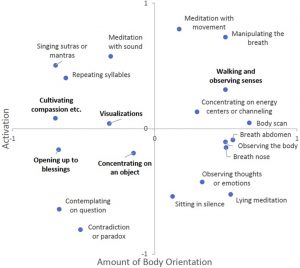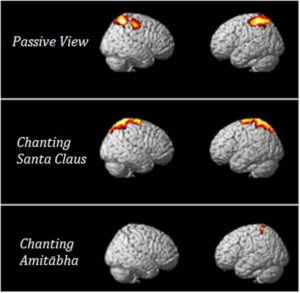By John M. de Castro, Ph.D.
“Om is a great tool for manifesting positive things in your life. Chanting Om calms your mind and helps you bring in positive energy into your body.” – Times of India
Contemplative practices have been shown to improve health and well-being. One ancient practice that is again receiving acceptance and use is chanting. It is a very common component of many contemplative practices. Chanting is claimed to be helpful in contemplative practice and to help improve physical and mental well-being. OM chanting has been practiced for centuries. But there is very little empirical research on OM chanting or its effectiveness.
In today’s Research News article “Immediate Effects of OM Chanting on Heart Rate Variability Measures Compared Between Experienced and Inexperienced Yoga Practitioners.” (See summary below or view the full text of the study at: https://www.ncbi.nlm.nih.gov/pmc/articles/PMC9015091/ ) Inbaraj and colleagues recruited healthy adult yoga practitioners and yoga naïve individuals and had them perform a loud OM chant for 5 minutes. They were assessed before and after the chanting with an electrocardiogram for assessment of heart rate variability.
They found that at baseline the yoga practitioners had significantly higher levels of high frequency heart rate variability than the yoga naïve group. Compared to baseline and the yoga naïve group after chanting the experienced yoga practitioners had a significant increase in high frequency heart rate variability. The greater the number of years of experience practicing yoga the greater the increase in high frequency heart rate variability.
Increases in heart rate variability indicates a reduction in physiological activation, an increase in parasympathetic relaxation, providing a physiological indicator of calm relaxation. So, the results suggest that practicing yoga increases the ability to relax both in general and after chanting.
Promote the ability to relax with yoga.
“OM is present in everything that we speak. It is the sound of the Universe and everything that it contains. The primordial sound from which everything emerged.” – Meditative Mind
CMCS – Center for Mindfulness and Contemplative Studies
This and other Contemplative Studies posts are also available on Twitter @MindfulResearch
Study Summary
Inbaraj, G., Rao, R. M., Ram, A., Bayari, S. K., Belur, S., Prathyusha, P. V., Sathyaprabha, T. N., & Udupa, K. (2022). Immediate Effects of OM Chanting on Heart Rate Variability Measures Compared Between Experienced and Inexperienced Yoga Practitioners. International journal of yoga, 15(1), 52–58. https://doi.org/10.4103/ijoy.ijoy_141_21
Abstract
Background:
Chanting “OM” is a form of meditation that has numerous health benefits. However, the neurophysiological mechanisms underpinning its effect are surprisingly scarce. The present study aimed to investigate the effect of OM chanting on autonomic modulation, using heart rate variability (HRV), on experienced yoga practitioners and yoga naïve persons.
Methods:
This prospective study included 19 yoga practitioners (9 females and 10 males; group mean age ± standard deviation [SD]; 25.9 ± 3.2 years) and 17 yoga naïve persons (8 females and 9 males; group mean age ± SD; 24.8 ± 3.6 years) of both sexes and similar age range. Both the groups were assessed for HRV indices (time and frequency domain measures) before and after loud OM chanting for 5 min.
Results:
Baseline comparison using Mann–Whitney U test between groups showed yoga practitioners had significantly increased high frequency (HF) power (P < 0.029) than nonyoga practitioners, signifying a state of tranquility before the chanting of OM. After 5 min of loud chanting of OM, a comparison between groups assessed using Wilcoxon Signed Ranks test revealed: HF Power, a component of the parasympathetic nervous system, was further amplified with a significantly increase (P < 0.001) in the yoga practitioners group compared to nonyoga practitioners. Furthermore, this increase in HF power was positively correlated with the years of experience in yoga.
Conclusion:
The present study showed that a brief chanting of OM (5 min) might enhance parasympathetic nervous system activity, promote relaxation, and provide calmness. Further, this experience may be achieved effectively in individuals experienced in yoga than nonyoga practitioners.
https://www.ncbi.nlm.nih.gov/pmc/articles/PMC9015091/




